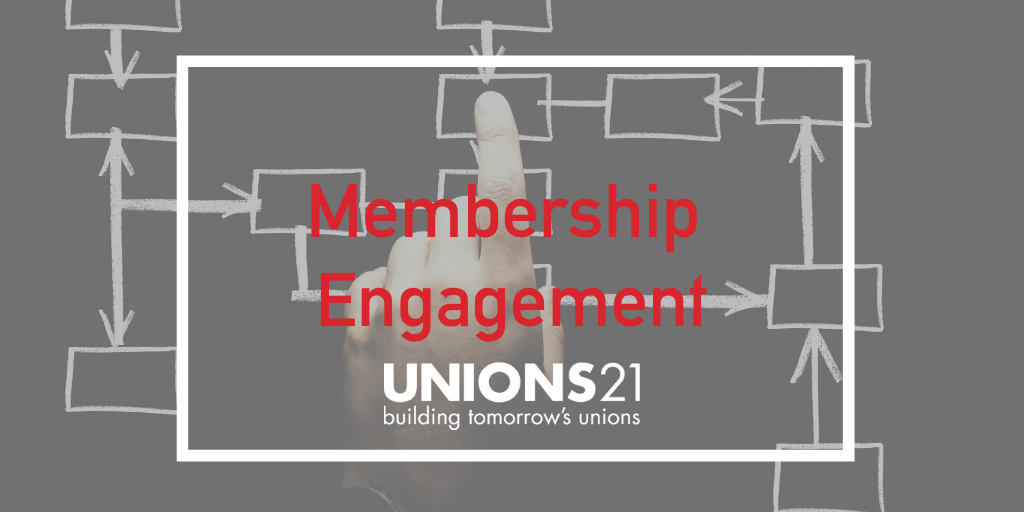By Vic Barlow, Unions 21 | 5 min
Thinking about member engagement might seem strange when we’re isolating ourselves from our colleagues and our members. But some time away from the usual routine gives us space to consider what works well now and what we could do better to keep our members engaged.
When it comes to members, many unions spend a lot of time and money on recruitment. But should we spend more time on considering how to retain members, especially in the first year when discounts might end?
Member engagement doesn’t work in isolation, it cuts across the union’s work. In this blog however, we’ll focus on the cycle of communications from membership, looking at the period from join to renew, but we’ll draw on other team’s work and we’ll consider how to share our planning.
General aims of member engagement are clear:
help each member see themselves in the union
show them that their work concerns and aspirations are heard and met
provide a route to get involved, to build loyalty and build the union
demonstrate value for money
ensure they make the choice to renew when they’re asked
Looking at the membership cycle from join to renew, over a rolling subs year you can plan a series of emails/letters which integrates into the overall unions' comms cycle and delivers specific content to specific segments of members.
Starting with ‘welcome to your union’ in week one and ending with ‘it’s time to renew’ in month 10/11, you can schedule comms at regular intervals, perhaps in months one, three, six and nine, with content that resonates with each segment of membership so they see themselves in the union.
As well as pushing content you know makes sense to members, you can also consider ‘how are we doing’ surveys in months three and/or six, so you can spot those members who aren’t happy and intervene early. You can also ask members what they’d like to hear from their union.
In a calendar subs year, where members often renew in fewer than 12 months, think about how many communications make sense between welcome and renewal, as overwhelming members in these early days will only lead to fatigue.
In both rolling and calendar years, a maximum of six contacts per year on the merits of membership is plenty (aside from necessary arrears/lapsed/cancelled comms) as the rest of the union will be sending out comms, and you don’t want unsubscribes from important membership communication.
But what could you communicate to each member segment in your regular slots? There are three main sources of content, two of which can be mapped into a calendar:
The cycle of professional activity where you can offer advice: for example, students/trainees looking for placements or jobs: colleagues wanting to move into leadership positions; members preparing for retirement
The cycle of union activity where you can encourage involvement: for example, elections, annual conferences, events
The third source of content is non-cyclical activity which can go into the calendar, to either fill the gaps between scheduled opportunities, or take precedence if it’s more relevant or urgent. Ask colleagues about what content they want to share, broken down where possible for different groups of members, for example:
What campaign asks could be made?
What surveys, consultation responses are underway?
What new advice has been issued from your case work and legal teams?
What events and training are planned?
This calendar of activity can be shared across the union to help integrate communications activities, share consistency of messaging and help prioritise what matters most to members at any given time.
Set yourself a reminder to update your scheduled comms every two to three months, or you will find you’re sending out irrelevant and outdated content!
For colleagues wondering how to keep recruitment going when you can't get into members' workplaces, your calendar will also provide a good source of content for distribution over organic and paid for social media. Right now, you should be pushing out to non-members your advice and case studies on managing the effects of COVID-19 on working conditions and professional practice to demonstrate the value of being part of a union.
So now you have your cycle of comms sorted, and members see themselves in the union thanks to your segmented content, how can you track engagement to identify members who might not renew and to spot members you never knew were so ‘active’ within the union?
Starting with members at risk of non-renewal, use your database’s engagement tracker (or your bulk email analytics) to find members who rarely or never interact with any of your channels, for example they’ve never opened or click through an email, answered a survey, attended an event.
Swap out the content in the comms for month nine, gently say you’ve noticed they’ve not got involved and ask them for their feedback. They might be too busy for union emails, but they might be dissatisfied, so you can intervene to hopefully save their membership and secure positive feedback for when they talk to their colleagues.
Now, thinking about members with high levels of online engagement, they might never show up to an event, but they always open and click through emails, answer a survey, post positively on social or order online. These members might be keen to get active, so work with your organising team on building a rapport to move them to greater involvement.
As noted at the start of this blog, member engagement doesn’t work in isolation. You can begin the process of creating a union-wide approach to engagement which demonstrates to members that you understand and respond to the issues which matter most to them. Right now, there’s nothing more important than working together to find solutions.



